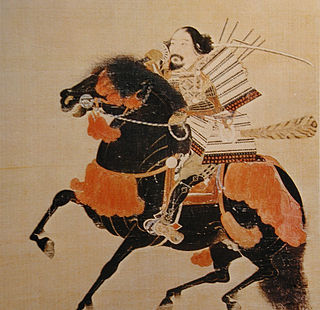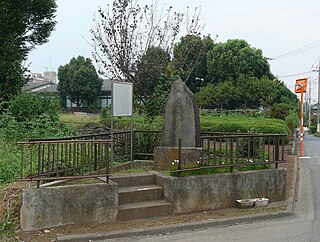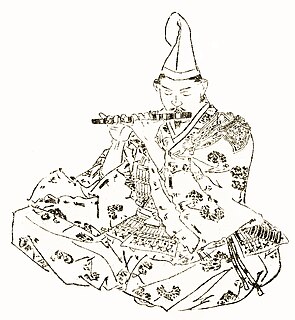
The Kamakura period is a period of Japanese history that marks the governance by the Kamakura shogunate, officially established in 1192 in Kamakura by the first shōgun, Minamoto no Yoritomo. The period is known for the emergence of the samurai, the warrior caste, and for the establishment of feudalism in Japan.

The Kenmu Restoration (1333–1336) is the name given to both the three-year period of Japanese history between the Kamakura period and the Muromachi period, and the political events that took place in it. The restoration was an effort made by Emperor Go-Daigo to bring the Imperial House back into power, thus restoring a civilian government after almost a century and a half of military rule. The attempted restoration ultimately failed and was replaced by the Ashikaga shogunate (1336–1575). This was to be the last time the Emperor had any power until the Meiji Restoration of 1868. The many and serious political errors made by the Imperial House during this three-year period were to have important repercussions in the following decades and end with the rise to power of the Ashikaga dynasty.

Ashikaga Takauji was the founder and first shōgun of the Ashikaga shogunate. His rule began in 1338, beginning the Muromachi period of Japan, and ended with his death in 1358. He was a descendant of the samurai of the (Minamoto) Seiwa Genji line who had settled in the Ashikaga area of Shimotsuke Province, in present-day Tochigi Prefecture.

The Nitta clan was one of several major families descended from the Seiwa Genji, and numbered among the chief enemies of the Hōjō clan regents, and later the Ashikaga shogunate. The common ancestor of the Nitta, Minamoto no Yoshishige, was the elder brother of Minamoto no Yoshiyasu, the common ancestor of the Ashikaga clan. Yoshishige was the a landowner in the Nitta District of Kōzuke Province in present-day Gunma Prefecture. Yoshishige supported Minamoto no Yoritomo in the Battle of Ishibashiyama of 1180 against the Taira clan.

Ashikaga Tadayoshi was a general of the Northern and Southern Courts period (1337–92) of Japanese history and a close associate of his elder brother Takauji, the first Muromachi shōgun. Son of Ashikaga Sadauji and Uesugi Kiyoko, daughter of Uesugi Yorishige, the same mother as Takauji, he was a pivotal figure of the chaotic transition period between the Kamakura and Muromachi shogunates. Tadayoshi is today considered a military and administrative genius and the true architect of many of his elder brother's successes. In contemporary chronicles he is rarely called with his name, but is instead called either gosho (御所) or Daikyū-ji-dono (大休寺殿) from the name of his family temple. His posthumous name was Kozan Keigen (古山慧源).
Hōjō Tokiyuki was a samurai of the Hōjō clan who fought both for and against the Imperial Court. His father was Hōjō Takatoki, last Shogunal Regent and de facto ruler of the Kamakura shogunate.

Hōjō Takatoki was the last Tokusō and ruling Shikken (regent) of Japan's Kamakura shogunate; the rulers that followed were his puppets. A member of the Hōjō clan, he was the son of Hōjō Sadatoki, and was preceded as shikken by Hōjō Morotoki.

Tōshō-ji (東勝寺) was the Hōjō clan's family temple (bodaiji) in Kamakura during the Kamakura period. Its founder was Taikō Gyōyū and it was constructed in 1237 by Hōjō Yasutoki in memory of his mother, who had her tomb there. According to the Taiheiki, from its foundation until the end of the Kamakura shogunate every regent (shikken) was buried there. The temple no longer exists, since it was set on fire by the Hōjō themselves when the entire family committed suicide after Nitta Yoshisada's invasion of Kamakura on July 4, 1333. Its ruins were found in the Kasaigayatsu valley in today's Ōmachi. Tōshō-ji very probably used to occupy the entire valley. Standing at the top of a narrow valley shut off at its base by the Nameri river's deep gorge and by steep hills on the other three sides, and besides offering a clear view of the only road that crossed the river, it was a fortress surely valuable to the family also from the military point of view.

Inamuragasaki (稲村ケ崎) is a cape at the western end of Yuigahama (Beach) in Kamakura, Kanagawa Prefecture, Japan. The cape divides Yuigahama from Shichirigahama (Beach) and Enoshima. Its name seems to stem from its shape, similar to a stack of rice at harvest time. At its foot on the Shichirigahama side there is a park, the Inamuragasaki Park (稲村ケ崎海浜公園).

The Battle of Kotesashi was part of the decisive Kōzuke-Musashi Campaign during the Genkō War in Japan that ultimately ended the Kamakura Shogunate. Fought in present-day Tokorozawa, Saitama on May 11, 1333, it pitted the anti-shogunate imperial forces led by Nitta Yoshisada against the pro-Shogunate forces of the Hōjō Regency led by Sakurada Sadakuni. The next day, the forces again engaged each other in the Battle of Kumegawa. The result of these two days was a victory for the Imperial forces who in less than one week marched 50 kilometers south and finally defeated the Shōgun's forces during the Siege of Kamakura.

Shichirigahama (七里ヶ浜) is a beach near Kamakura, Kanagawa prefecture, Japan, which goes from Koyurigimisaki Cape, near Fujisawa, to Inamuragasaki Cape, west of Kamakura. Since from it one could enjoy a clear view of both Mount Fuji and Enoshima at the same time, during the Edo period it was popular as a subject for ukiyo-e. For example, famous ukiyo-e artists Hiroshige and Hokusai both include it in their 36 Views of Mount Fuji. Its dark sands are rich in iron ore which allowed Kamakura to become a florid center for the production of swords and knives. Its name is usually translated into English as "Seven Ri Beach", the ri being a unit of measurement.
Sakurada Sadakuni is referred to in the Taiheiki as grand marshal in command of the Shogunate forces during the Kōzuke-Musashi Campaign.

Kinryūzan Shakuman-in Endon Hōkai-ji (金龍山釈満院円頓宝戒寺) is a Buddhist temple in Kamakura, Kanagawa Prefecture, Japan. Often called Hagidera (萩寺), or "bush-clover temple", because those flowers are numerous in its garden, its existence is directly linked to a famous tragedy that on July 4, 1333 wiped out almost the entire Hōjō clan, ruler of Japan for 135 years. The temple was founded expressly to enshrine the souls of the 870 members of the clan who, in accordance with the samurai code of honor, committed suicide on that day at their family temple (bodaiji) of Tōshō-ji to escape defeat. Together with ancient Sugimoto-dera, Hōkai-ji is the only temple of the Tendai denomination in Kamakura. Formerly a branch temple of the great Kan'ei-ji, after its destruction it became a branch of Enryaku-ji.

Ashikaga Motouji (足利基氏) (1340–1367) was a warrior of the Nanboku-chō period. The fourth son of shōgun Ashikaga Takauji, he was the first of a dynasty of five Kantō kubō, Kamakura-based representatives in the vital Kamakura-fu of Kyoto's Ashikaga regime. Meant to stabilize a volatile situation in the Kantō, a region where many warrior clans wanted the return of the shogunate from Kyoto back to Kamakura, the dynasty he started almost immediately developed the ambition to usurp the shogunate, becoming a serious headache for the central government. Motouji was the only kubō who always remained loyal to the Kyoto government. During the Kannō disturbance, a historical episode with serious repercussions on his life, he tried to reconcile his father with his uncle Ashikaga Tadayoshi and, after his father's demise, he collaborated with his elder brother, shōgun Ashikaga Yoshiakira, to stabilize the shogunate. He died still young during an epidemic.


















